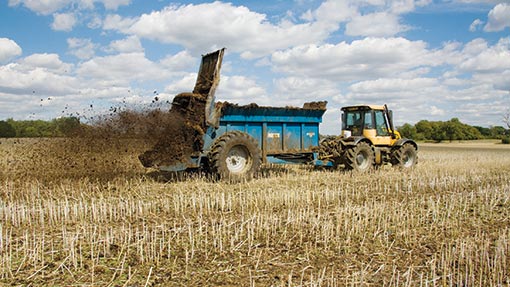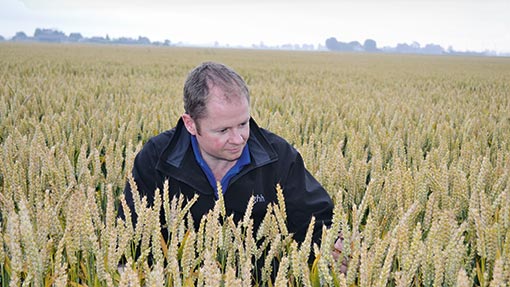In your hands: Break yield barrier to meet food demand

In the third of a new series, Crops, in association with BASF, showcases why the biggest job on earth is in farmers’ hands. Here Caroline Stocks looks at how growers can produce more as well as the challenge in breaking the yield barrier.
Since the mid-1990s, UK wheat yields have remained stubbornly flat, but in the face of feeding an ever increasing number of people, delivering more from crops is more important than ever before.
Genetic improvements have made it possible for wheat yields to increase by 0.5% and oilseed rape yields to rise by 2% each year, but on farm the reality has been every different.
From a food security perspective, it is not enough, says Bill Clark, NIAB TAG’s commercial director.
“Yields are not going up quickly enough to take into account population growth,” he says. “It’s a real challenge. There isn’t any more land being made available, so unless we can increase yields, we have a real issue in terms of food security.”
Unfortunately for growers, there is not one simple solution to give yields the jump-start they need.
A report by the organisation, commissioned by the HGCA and DEFRA in 2011, identified three broad areas that factored on yields: genetics, climate and agricultural practices, each bringing its own challenges.
“In the past, plant breeders had the most effect on yield, but we are at a point where trying to push them any harder is difficult,” Mr Clark says.
“They have done a tremendous job of doubling yields twice and have optimised traits such as dwarfing genes, but it’s getting harder to push the genetic potential further.”
Increasing tolerance to certain pesticide groups and pressures from the EU resulting in certain chemicals being lost from farmers’ armouries mean developments are often compromised, he adds.
And regardless of the steady increases being achieved in variety trials, the effects of climate and agronomic practice are limiting developments.
| Food supply: the figures | |
|---|---|
| 0.5% | The amount wheat yields could be increased year on year |
| 2% | The amount oilseed rape yields could be increased by each year |
| 14.3t/ha | is the wheat yield achieved in 2011 by Lincolnshire farmer David Hoyles |
| 7.7t/ha | is the average English wheat yield (DEFRA five-year average) |
Maximum spring and autumn temperatures have risen 0.5C since 1980, NIAB’s report found, resulting in cereals’ grain-fill period being reduced by 6%. Furthermore, during the past 15 years, April has typically been drier, which has limited crops in drier regions.
“On farm we are not seeing farmers taking full advantage of the genetic potential of varieties either,” Mr Clark adds.
“This isn’t to say our farmers are not good enough. There are complicated reasons why farmers never get the yields we get in trials and there’s a degree of compromise in crop management that means farmers can’t always achieve maximum yields.”
Simple rotations that compromise soil structure, water availability, machinery use and even diesel costs can all have an effect on yields, he says.
“The price of nitrogen fertilisers has been a big issue too. It’s a complicated situation and there are a lot of things that all add up.”
Ian Matts, Yara agronomic co-ordinator, says a better understanding of fertiliser application rates could affect yields, but it requires more on-farm education.
“There’s a lack of understanding about how many nutrients should be applied,” he says.
“We can look at fertiliser manuals, but it is difficult to apply the same instructions across the UK and expect good results.
“You have to deal with specific conditions, not only in different regions, but in different parts of the fields. It’s a case of managing soil types, and I’m not sure everyone is doing that yet.”
Mr Matts says variable-rate application can have many benefits, but there are still difficulties with phosphates and potash application.
“There’s a lack of understanding of the basics, knowing how to vary them and whether they need supplementing with traditional inputs.”
Looking longer term, Mr Clark is positive about the potential of novel breeding techniques such as NIAB’s synthetic wheats, which are being produced for use in commercial breeding programmes, offering great leaps in yield.
Although the first varieties to come from this work aren’t likely to be on the market before 2022, the project aims to increase the genetic diversity in wheat by introducing new genes from the crop’s wild ancestors.
The technique employed by NIAB recreates the rare hybridisation event that took place many years ago between an ancient wheat and wild grass species, says Mr Clark.
NIAB research director Andy Greenland says it represents a step-change in UK wheat yield potential. “Early trials have recorded yields 30-40% above the elite parent.”
Field trial data from Rothamsted Research and Nottingham University also point at potential savings in greenhouse gas emissions, as these new lines can maintain much of their yield under reduced nitrogen fertiliser inputs.
See also In your hands: Food security
See also In your hands: Food quality
David Hoyles, Lincolnshire
David Hoyles broke the British wheat yield record in 2011 with an average 14.3t/ha crop on his 550ha farm in Lutton, Lincolnshire.
While his deep silt soils on the edge of The Wash mean he farms some of the country’s most fertile land, it’s attention to detail that helps drive yields, Mr Hoyles says.
“It all revolves around looking after the soil, which means having a varied rotation to help with nutrient and organic matter of the soil.
“There are limits to what your soil type can achieve, but whether you have sufficient sunlight or organic matter, you have to do the best with what you have,” he says.
Mr Hoyles grows wheat as a break crop among five years of vegetable crops, but he says types of drills, variety choice, timings and general crop husbandry all play their part along with the varied rotation.
“We grow a relatively small amount of wheat, so we spray our crops in one day. It means we can be more precise with our timings and get the details right. I read about what other people are doing and use technology where I can.”
Getting buy-in from his staff is also important, he adds.
“We are very open about what we are trying to achieve, so we are all moving towards the same goal. It’s not all about maximising yields – you have to look at your levels of inputs to maximise returns.”
Talking to local growers also helps him get the best from his land, he says. “There’s so much information out there that it can be confusing, so talking to growers with similar rainfall or rotations really helps.”
But despite his best efforts, yields can differ hugely from one year to the next – a situation that is only getting worse as extreme weather events become more common.
“The weather extremes are out of our hands,” he says. “In 2011 we broke the yield record, but the following year our average was 8.5t/ha.
“We didn’t try any less, the weather just curtailed our potential. In those situations it’s about damage limitation.”
Mr Hoyles hopes developments in technology will help crops cope with the climate, while the introduction of hybrid wheats should help achieve jumps in yield.
“We are still learning and improving,” he adds. “The way forward is for local farmers to work together with their soil types, rotation and climate to learn what the others are doing and improve from there.”

Rob Gladwin
Head of sustainability, BASF
The mega trends are as clear as they are complex. The global population is growing, dietary habits are changing and resources are becoming more pressured – namely water, arable land, energy and biodiversity. British farmers are in a comparatively strong position – soils are generally good, water is available – in some cases abundant – and access to good crop genetics and agronomy inputs is adequate at present. Yet for growers to address the mega trends at farm level, yields need to rise markedly and the efficiency of production for every tonne harvested needs to improve much more.
Society is looking to farmers to make these changes and we hope that, as a company, BASF is playing its part to support farmers.
The main strands of our support are lobbying to protect the active ingredients farmers have, investing into industry-valuable research such as the application of precision mapping and investing in developing new active ingredients for the future. Our company invests more than €469m (£387m) into agricultural R&D annually, and as well as crop protection, we are investing in plant health, water use and nutrient use efficiency.
Sadly there is no magic bullet to help yields increase. The levels of skill are increasing on farms both in terms of technical and environmental expertise, and the challenge is to make both of these work together so that farms make a profit.
At BASF, the focus of R&D is simple. We are committed to conventional crop protection chemistry, whether it’s the discovery of new molecules or defending existing products through re-registration.
In addition, our quest beyond conventional chemistry into biological solutions is highlighted by the €750m purchase of Becker Underwood last year and research focused on novel technology that offers the opportunity to unlock crop potential by targeting plant stress, nutrient and water management. Hopefully, these will allow farmers to better manage their resources.

